K. Lam, N.M.J. Rupniak, S.D. Iversen
Merck Sharp and Dohme Research Laboratories,
Neuroscience Research Centre, Essex, U.K.
Accepted for publication March 16, 1990.
We examined the effects of a synthetic fleece pad on cage stereotypies in individually housed cynomolgus monkeys. Animals which received the fleece alone engaged in grooming which was associated with an increase in time spent resting. Monkeys given fleece pads sprinkled with morsels of food did not groom the fleece, but rather foraged for long periods (up to 27 min/h). Stereotyped behaviours were reduced by up to 73% by use of the fleece pad both alone and with foraging crumbles.
Key words: grooming - foraging - stereotypy - institutionalization
Introduction
In captivity, social grooming and other tactile stimulation is often limited or impossible, especially for individually housed monkeys, and this may contribute to the development of isolation syndromes. Infant rhesus monkeys reared in cages so that they could hear and see, but not touch, conspecifics developed severe isolation syndromes; these could be attenuated by even limited tactile contact through a wire mesh partition or by gradual social rehabilitation [10, 11]. Opportunities for tactile contact with other species, such as dogs and kittens, can also have a dramatic therapeutic effect on behaviour in isolate- reared monkeys [7,9]. Isolate-reared primates appear to gain "contact comfort" even from inanimate objects as revealed by their eagerness to cling to surrogate mothers only if they were draped in a soft fabric [5].
For these reasons we were curious to examine whether individually housed monkeys would show an interest in grooming a synthetic fleece pad which could be easily introduced into the cage and washed each day if required. Because of the known beneficial effects of allowing monkeys to forage [1,2], we also examined whether combining the opportunity to groom with foraging in the same fleece substrate would be even more effective than grooming alone in alleviating cage stereotypies.
Materials and methods
Subjects
The subjects were six adult male cynomolgus monkeys (Macacafascicularis) approximately 13 years of age. These animals had previously served as subjects in an earlier environmental enrichment study [1], and had well-established cage stereotypies. Monkeys were allocated to two experimental groups: one received fleece alone, and the other received fleece and foraging crumbles. The three monkeys receiving fleece alone were observed one at a time in the same order on alternate days from the group which received fleece with crumbles. The study progressed for 12 consecutive days, providing six days of observation for each group. On altenate days when monkeys were not scored, fleece or fleece with crumbles was introduced into the cage and removed at the same time of day as on observation days. Monkeys allocated to the fleece alone group never received foraging crumbles; animals in the fleece with crumbles group never received fleece alone.
Animals received fleece with or without crumbles at strictly the same time of each day (between 08:00 and 16:00). Food was withheld until after completion of behavioural testing (approximately 16:30). For the purpose of the present study animals were housed individually in adjacent wall-mounted cages (0.72 X 1.2 X 0.6 m) (described in detail by Bryant et al. [1]). All observations were carried out in the home cage.
Grooming and foraging substrates
The grooming substrate was a washable synthetic fleece fabric commonly employed for veterinary care (Vet Bed; IMS, Cheshire, U.K.). The fleece was folded and securely stitched with nylon sutures to forma cushion (approximately 0. 2 X 0. 2 X 0. 6 in) which could be introduced into the cage with the animal. Monkeys received either fleece alone, or fleece which had been sprinkled with tidbits of familiar or novel foods and flavours [puffed rice "Rainbow Drops" (Matlows, UK) or Foraging Crumbles (Bioserve, New Jersey) in lemon, strawberry, and apple flavours].
Behavioural assessment
The behavioural repertoire of each animal was recorded by an observer sitting approximately one in from the front of the home cage. Behaviours were recorded under the following main categories: resting (sitting quietly or sleeping on the perch or cage floor), autogrooming (plucking at or parting of the animal's own hair), and stereotypy (repetitive pacing, circling, swaying, bouncing, cage-charging, and rocking). Activities directed towards the fleece with or without crumbles (grooming or foraging) were recorded separately. The total duration of these behaviours during each observation period was recorded. The animals were scored for one h before introduction of the fleece (baseline observation period) and for one h immediately thereafter.
Bacteriological analysis of fleece
Rodac plates (Replicate Organism Detection and Counting; BBL, Cockeysville, U.S.A.) were used to monitor the surface cleanliness of the fleece with or without crumbles before and after introduction to the cages. The agar surface of the Rodac plate was applied directly to an area of fleece previously outlined with an indelible marker. Samples were taken from each piece of washed fleece before and after introduction into the monkeys' cages. Rodac plates were incubated at 35'C for 28 h and bacterial colonies were then counted.
Statistical analysis
The total duration of different behaviours was summed over the one-h observation period. Behaviours in the home cage before and after the introduction of fleece with or without crumbles over the six days of observation were compared by two-way analysis of variance with repeated measures.
Results
Stereotyped behaviour
Animals exhibited idiosyncratic repertoires of stereotyped behaviour, including repetitive pacing, swaying, circling, bouncing, cage charging, and rocking. These activities occupied on average 11% of the baseline observation periods and were similar in both groups of monkeys (fleece alone group: 8 ± min/h; fleece + crumbles group: 10 ± 0. 6 min/h). The duration of stereotypy during the baseline observation periods did not alter during the study (fleece alone group: score on day 1 = 11.4 ± 6.7 min, score on day 6 = 10.0 ± 6.0 min; fleece + crumbles: score on day 1 = 7.4 ± 1.5 min, score on day 6 = 10.7 ± 4.5 min; F = 0.69, P = 0.64, two-way analysis of variance with repeated measures). Autoaggression was not consistently observed.
The introduction of fleece either with or without crumbles into the monkeys' cages caused a marked reduction in time spent engaged in stereotypies as compared with the baseline observation period immediately before introduction of the fleece. In the presence of fleece alone there was a reduction of around 53% in time spent in stereotyped behaviours (F = 58.99, P = 0.017; Fig. 1). There was no tolerance to this reduction in stereotypy s cores during the six days of observation in either group (fleece alone group: F = 0.69, P = 0.64; fleece + crumbles group: F = 0.80, P = 0.52). Although there appeared to be a greater reduction (around 20%) in stereotypies in monkeys given fleece + crumbles compared to monkeys given fleece alone, this did not reach significance (F = 0.02, P = 0.88).
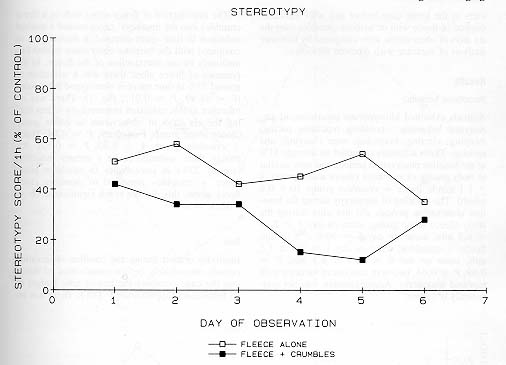
Rest
Inactivity or rest during the baseline observation periods immediately before introduction of fleece into the cage occupied the largest time budget of all behaviours (approximately 33%). There was no change in the baseline duration of rest over the six days of observation (fleece alone group mean = 15.9 ± 1.4 min, F = 1.01, P = 0.46; fleece + crumbles group mean = 25.8 3.1 min, F = 1.41, P = 0.11).
Introduction of fleece with or without crumbles had a pronounced effect on the amount of time spent resting compared with levels observed during the baseline period. Monkeys given fleece alone displayed a marked increase (57%) in the time spent at rest (sitting quietly with eyes closed or sometimes asleep in a hunched position) (F = 46.02, P = 0.02; Fig. 2). In contrast, the opposite effect, a decrease (23%) in resting, was observed in monkeys given fleece + crumbles (F = 32.47, P = 0.03; Fig. 2). The duration of rest during the six-day study did not alter in either group (fleece alone group: F = 1.01, P 0.46; fleece + crumbles group: F = 2.41, P = 0.11).
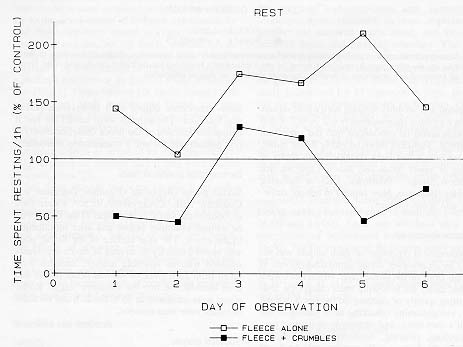
Autogrooming
On the first day of observation, monkeys in both experimental groups spent similar amounts of time autogrooming during the one-h baseline period (fleece alone group: 9.6 ± 3.0 min; fleece + crumbles: 9.7 ± 3.2 min). However, as the study progressed, there was an increase of up to 45% in the amount of time spent autogrooming during the baseline observation periods in the monkeys who subsequently received fleece alone compared with monkeys who subsequently received fleece + crumbles (F = 12.30, P = 0.03; Fig. 3).
After introduction of fleece to the cages, there was no significant change in the time spent autogrooming in either group during the study (fleece alone: 11.0 ± 1.9 min; fleece + crumbles: 8.4 ± 1.1 min; F = 0.68, P = 0.64).
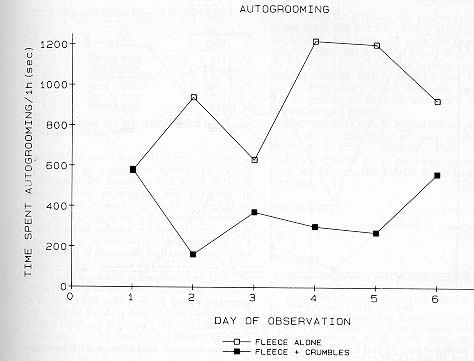
Activities directed at fleece
Grooming. Monkeys given fleece alone would typically squat on the cage floor or sit on the perch and gently pluck at, stroke, or part small pieces of fleece with their fingers. This behaviour was often accompanied by lipsmacking; inactivity or rest following grooming of the fleece was frequently observed. Monkeys given fleece alone spent approximately six times as long grooming the fleece (6.4 ± 1.2 min) as monkeys given fleece + crumbles (1.0 ± 0.6 min; F = 19.48, P = 0.01; Fig. 4). There was no evidence of tolerance to grooming the fleece during the course of the study in either group (F = 0.99, P = 0.45).
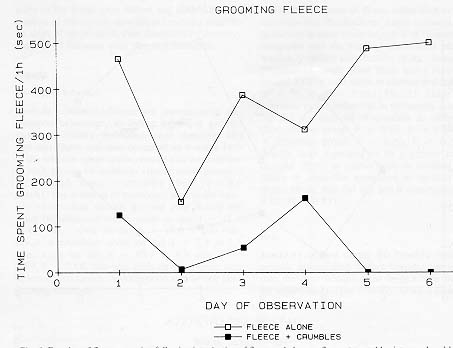
Foraging. Monkeys given fleece + crumbles were engaged predominantly in foraging and feeding activities, sitting or squatting on the perch or cage floor, picking out crumbles among the fleece with their fingers and consuming them, or directly licking the fleece; this was not usually accompanied by lip smacking (mean duration = 15.3 ± 5.3 min). The amount of time spent foraging varied markedly depending on the flavour of crumbles employed. Flavours which the monkeys were not familiar with (lemon, strawberry, and apple) attracted relatively little interest (6.7 ± 0.7 min). In contrast, a tidbit which the monkeys were familiar with (Rainbow Drops) attracted considerably more interest (24.0 ± 2.5 min, Table 1).
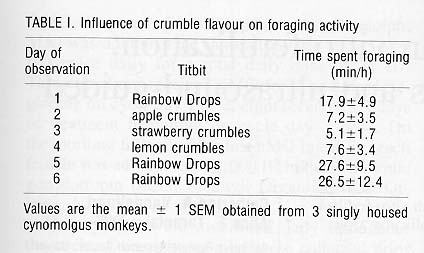
Bacteriological analysis of fleece
Rodac culture plates exposed to washed fleece gave rise to less than five bacterial colonies. Samples taken from fleece with or without crumbles after a single experimental period revealed growth of bacterial colonies in excess of 50 in both conditions.
Discussion
Supplying singly-housed monkeys with an artificial fleece pad which they could groom or from which they could pick morsels of food dramatically reduced cage stereotypies (by up to 73%). Provided the fleece is washed frequently (probably daily) this procedure is a cheap, simple, and extremely effective method to relieve institutionalisation behaviours in macaques.
The striking success of the fleece pad alone strongly suggests a therapeutic effect of grooming on behaviour. When engaging in social grooming monkeys often convey the impression of extreme relaxation. In the present study, monkeys also appeared relaxed after grooming the fleece and often even fell asleep (as shown by the 57% increase in time spent resting). Prior to introducing the fleece into the cage, the monkeys showed a surprising increase (up to 45%) in autogrooming, possibly in anticipation of receiving the fleece. The mechanism by which grooming may influence stereotyped behaviour is not known. However, changes in the release of endogenous opiates, particularly P-endorphin, are associated with social isolation, autoaggression, stereotypies, and grooming. In tethered sows, stereotypies could be blocked by naloxone [3], suggesting that stereotyped behaviour might serve to enhance endorphin release and so relieve stress, or alternatively that stereotypy is a consequence of abnormally high endogenous opiate activity. It is of interest that self-injurious behaviour in autistic patients is associated with high CSF levels of endogenous opiates and may be decreased by treatment with naltrexone [6]. Finally, when isolated talapoin monkeys were allowed social contact (mainly involving grooming), this was followed by an elevation in CSF P-endorphin levels. Opiate receptor blockade by naltrexone increased monkeys' desire to be groomed, whilst morphine-treated animals avoided grooming [8]. In man, heart rate and blood pressure are reduced when stroking domestic pets, and dogs have been employed with some success in behaviour therapy for institutionalized and depressed people [4]. Behaviour therapy using tactile stimulation in psychiatric conditions where stereotyped and injurious behaviour are common might be of particular value.
In addition to evaluating the therapeutic effects of the fleece pad alone we were interested to determine whether combining the possibility to groom with the opportunity to forage would reduce stereotypy to an even greater extent. Although animals given fleece + crumbles exhibited a slightly lower frequency of stereotypy (20% lower duration on average), this difference was not significant. However, the provision of fleece alone or fleece + crumbles had quite different behavioural effects. Monkeys given fleece + crumbles rarely, if at all, groomed the fleece (grooming was six times higher in monkeys given fleece alone). Instead, the predominant activity was foraging. The presence of food became the prepotent cue guiding behaviour to the fleece and this was strongly influenced by the animals' preferences for particular foods and flavours. Thus, any beneficial effects of grooming the fleece would only be derived by using a separate foraging substrate, such as woodchip litter. Unlike the monkeys who groomed the fleece, monkeys who foraged did not show any alteration in resting or autogrooming patterns.
Where monkeys must be housed individually we would strongly recommend provision of separate grooming and foraging substrates. These can be readily incorporated into all cages with minimal expense and demonstrable benefits to the monkeys' behaviour.
Acknowledgment
Kenneth Lam is a Universities Federation for Animal Welfare Scholar.
References
I . BRYANT CE, RUPNIAK NMJ, IVERSEN SD: Effects of different environmental enrichment devices on cage stereotypies and autoaggression in captive cynomolgus monkeys. J Med Primatol 17:257-270, 1988.
2. CHAMOVE AS, ANDERSON JR, MORGAN-JONES SC, JONES SP: Deep woodchip litter: Hygiene, feeding and behavioural enhancement in eight primate species. Int J Stud Anim Prot 3:308-317, 1982.
3. CRONIN GM, WIEPKEMA PR, VAN REE JM: Endogenous opioids are involved in stereotyped behaviour of tethered sows. Neuropeptides 6:527-530, 1985.
4. CULLITON BJ: Take two pets and call me in the morning. Science 237:1560-1561, 1987.
5. HARLOW HF, HARLOW MK: Psychopathology in monkeys. In Kimmel HD (ed): "Experimental Psychopathology: Recent Research and Theory. " New York: Academic Press, 1971, 203-339.
6. HERMAN BH, HAMMOCK MK, ARTHUR-SMITH A, CHATOUR 1, ZELINK N: Naltrexone decreases self-injurious behaviour. Ann Neurol 22:550-552, 1987.
7. HUEBNER DK, KING JE: Kittens as therapists: Social behaviour sequences in isolated squirrel monkeys after exposure to young nonconspecifics. Dev Psychobiol 17:233242, 1984.
8. KEVERNE EB, MARTINEz ND, TUITE B: Beta-endorphin concentrations in cerebrospinal fluid of monkeys are influenced by grooming relations. Psychoneuroendocrinology 14:155 -161, 1989.
9. MASON WA, KENNEY MD: Redirection of filial attachments in rhesus monkeys: Dogs as mother surrogates. Science 183:1209-1211, 1974.
10. Suomi SJ: The role of touch in rhesus monkey social development. In Brown C.C. (ed): "The Many Facets of Touch." Skillman, 1986, 41-50.
11. Suomi SJ, HARLOW HF: Social rehabilitation of isolate reared monkeys. Dev Psychobiol 6:487-496, 1972.
This article originally appeared in the Journal of Medical Primatology 20, 104-109 (1991).
Reprinted with permission of the Editor.